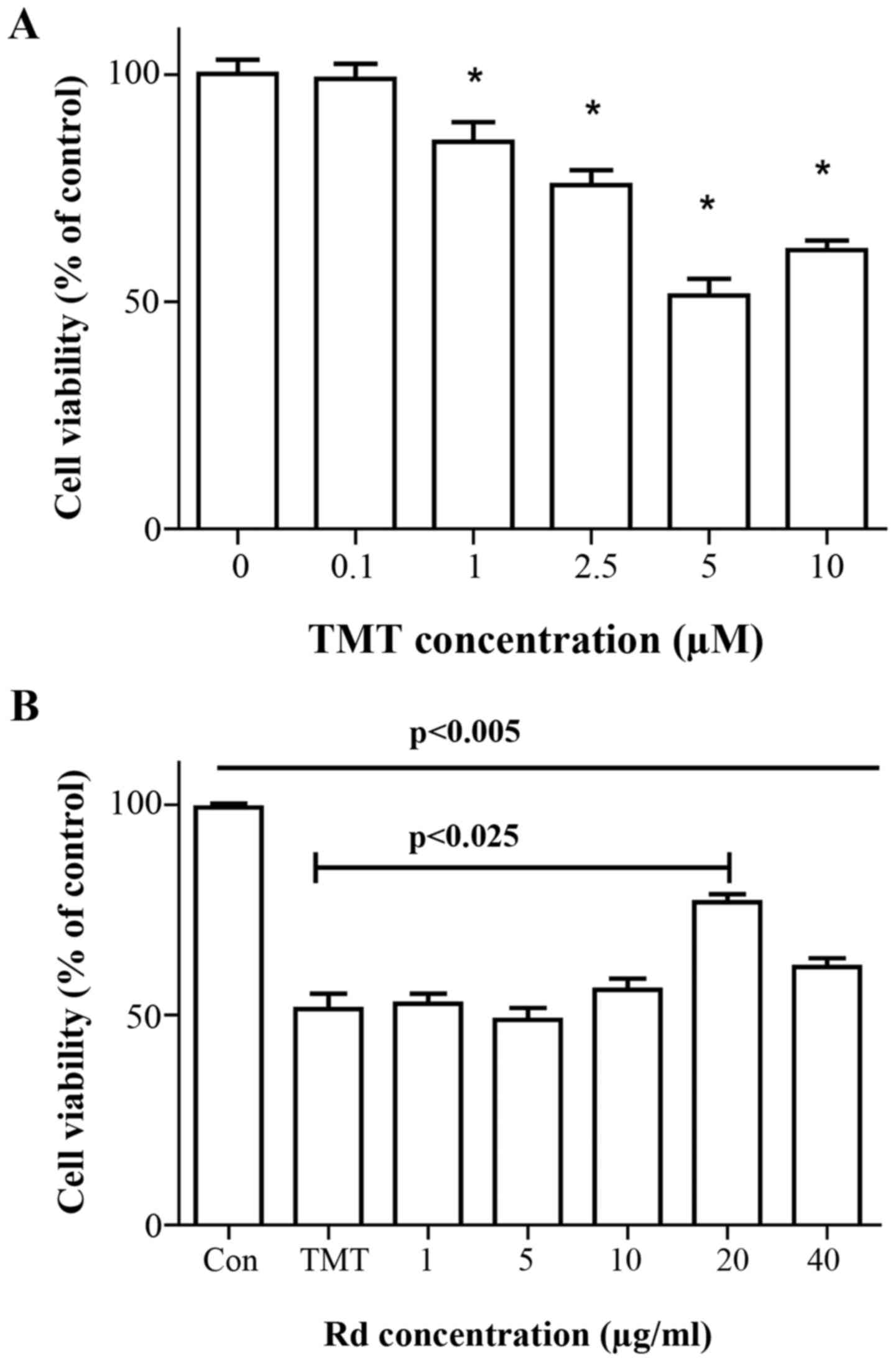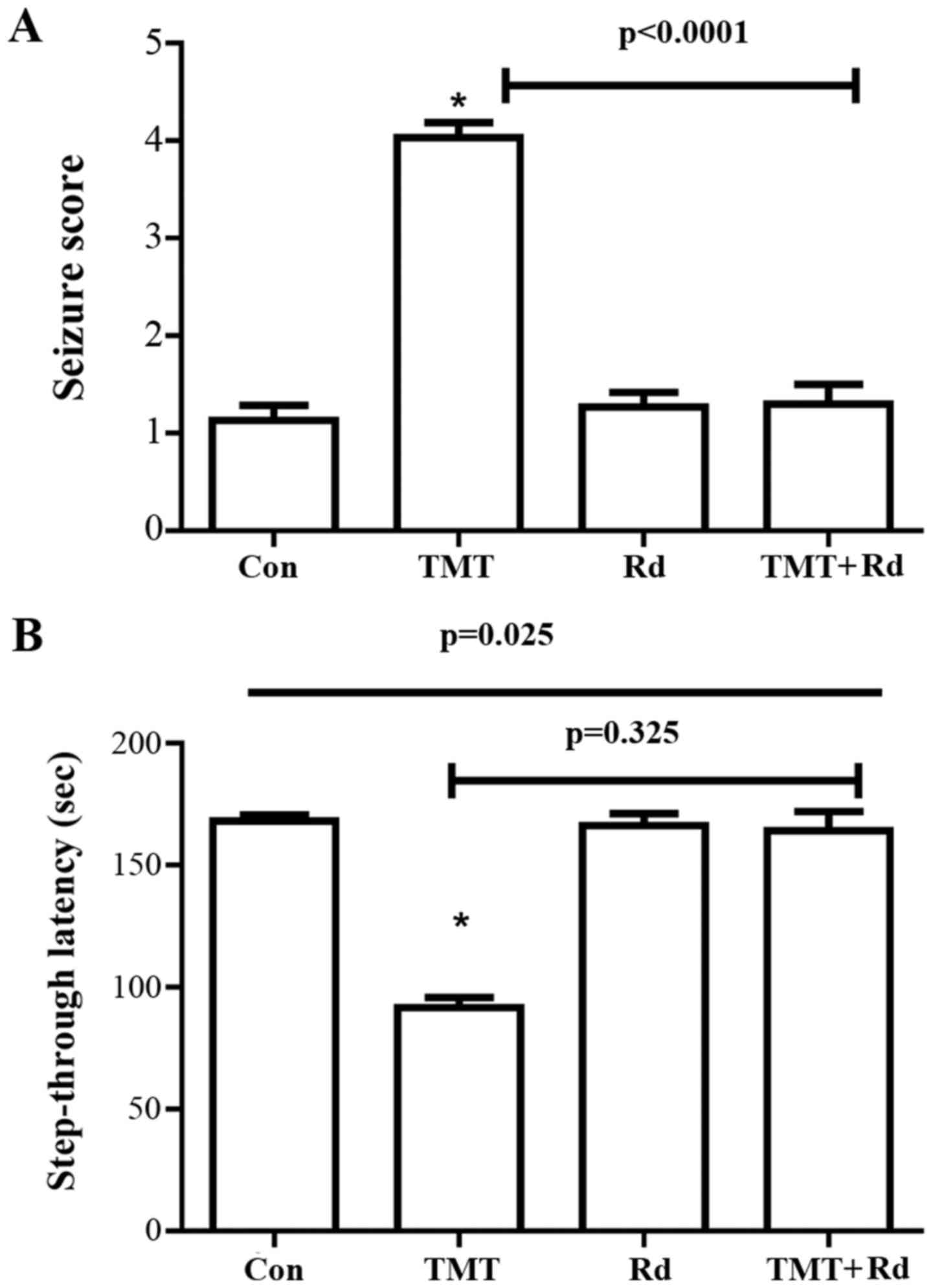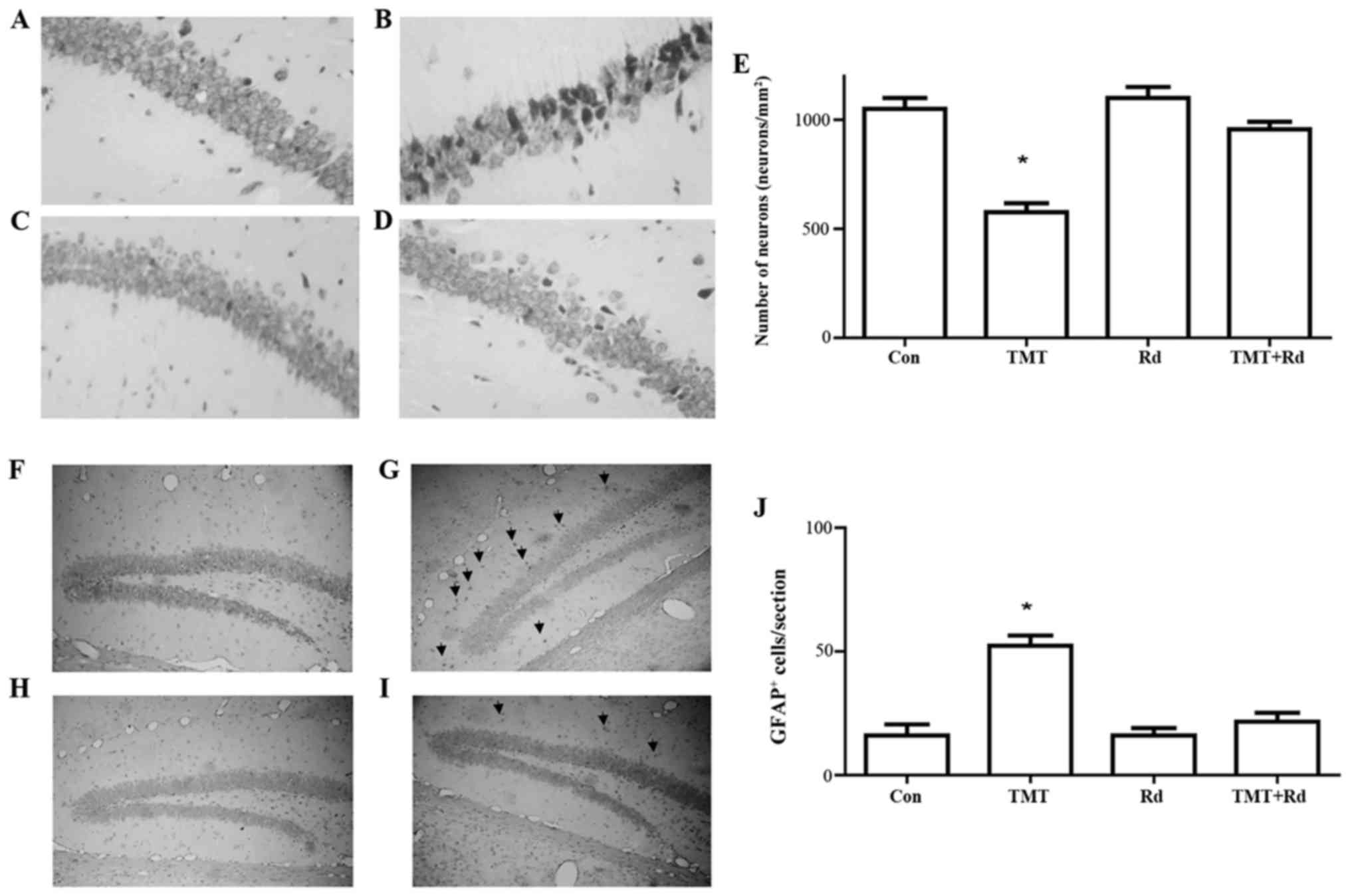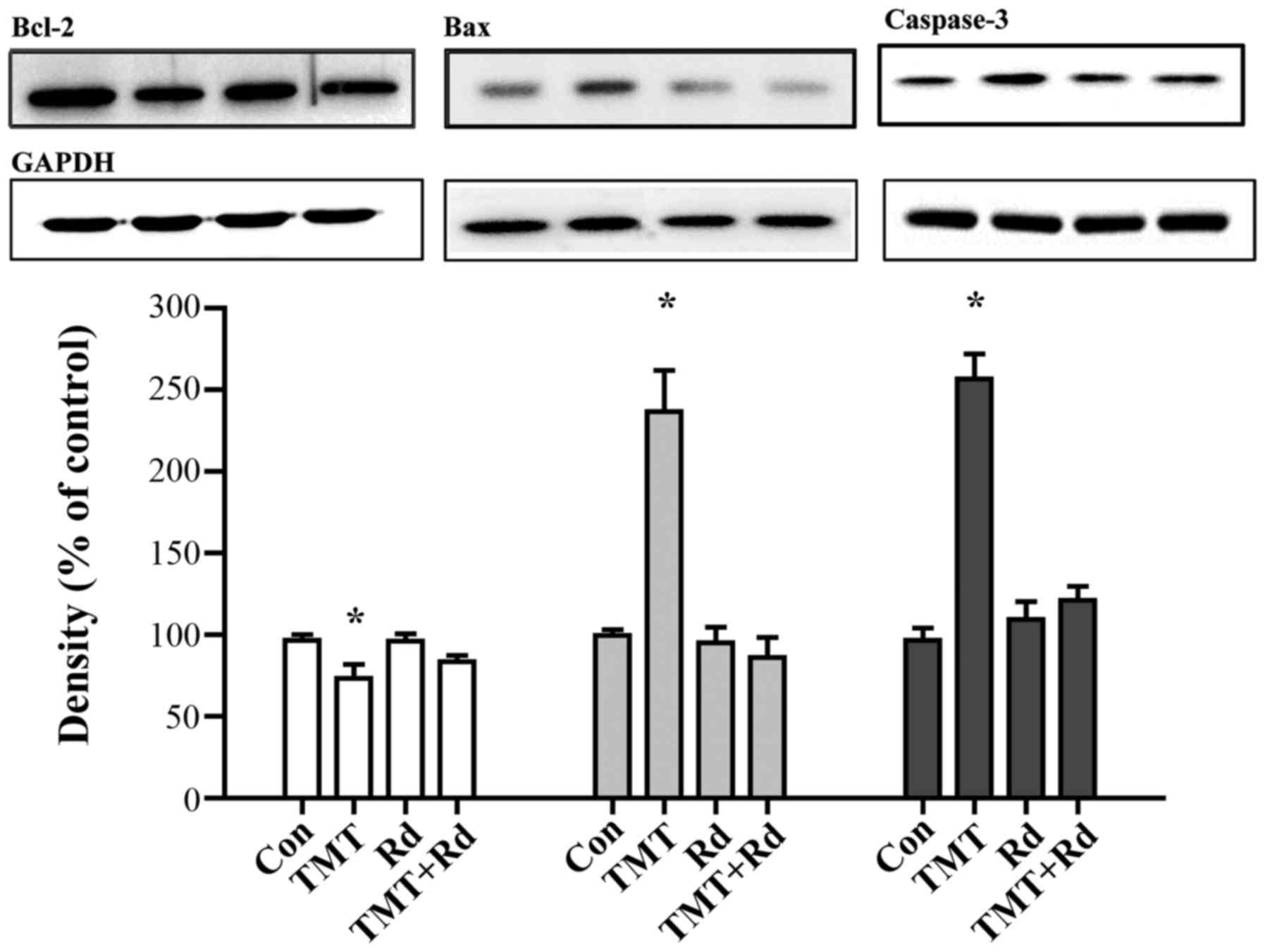|
1
|
Dorman DC: An integrative approach to
neurotoxicology. Toxicol Pathol. 28:37–42. 2000. View Article : Google Scholar : PubMed/NCBI
|
|
2
|
Ha JS, Jin DE, Park SK, Park CH, Seung TW,
Bae DW, Kim DO and Heo HJ: Antiamnesic Effect of Actinidia arguta
Extract Intake in a Mouse Model of TMT-Induced Learning and Memory
Dysfunction. Evid Based Complement Alternat Med. 2015:8764842015.
View Article : Google Scholar : PubMed/NCBI
|
|
3
|
Lattanzi W, Corvino V, Di Maria V,
Michetti F and Geloso MC: Gene expression profiling as a tool to
investigate the molecular machinery activated during hippocampal
neurodegeneration induced by trimethyltin (TMT) administration. Int
J Mol Sci. 14:16817–16835. 2013. View Article : Google Scholar : PubMed/NCBI
|
|
4
|
Kim J, Yang M, Kim J, Song L, Lee S, Son
Y, Kang S, Bae CS, Kim JC, Kim SH, et al: Developmental and
degenerative modulation of brain-derived neurotrophic factor
transcript variants in the mouse hippocampus. Int J Dev Neurosci.
38:68–73. 2014. View Article : Google Scholar : PubMed/NCBI
|
|
5
|
Bouldin TW, Goines ND, Bagnell RC and
Krigman MR: Pathogenesis of trimethyltin neuronal toxicity.
Ultrastructural and cytochemical observations. Am J Pathol.
104:237–249. 1981.PubMed/NCBI
|
|
6
|
Park HJ, Lee MS, Shim HS, Lee GR, Chung
SY, Kang YM, Lee BJ, Seo YB, Kim KS and Shim I: Fermented
Saccharina japonica (Phaeophyta) improves neuritogenic activity and
TMT-induced cognitive deficits in rats. Algae. 31:73–84. 2016.
View Article : Google Scholar
|
|
7
|
Shim HS, Park HJ, Ahn YH, Her S, Han JJ,
Hahm DH, Lee H and Shim I: Krill-Derived Phosphatidylserine
Improves TMT-Induced Memory Impairment in the Rat. Biomol Ther
(Seoul). 20:207–213. 2012. View Article : Google Scholar : PubMed/NCBI
|
|
8
|
Kaur S and Nehru B: Alteration in
glutathione homeostasis and oxidative stress during the sequelae of
trimethyltin syndrome in rat brain. Biol Trace Elem Res.
153:299–308. 2013. View Article : Google Scholar : PubMed/NCBI
|
|
9
|
Gasparova Z, Stara V, Janega P, Navarova
J, Sedlackova N, Mach M and Ujhazy E: Pyridoindole
antioxidant-induced preservation of rat hippocampal pyramidal cell
number linked with reduction of oxidative stress yet without
influence on cognitive deterioration in Alzheimer-like
neurodegeneration. Neuro Endocrinol Lett. 35:454–462.
2014.PubMed/NCBI
|
|
10
|
Kim HJ, Kim P and Shin CY: A comprehensive
review of the therapeutic and pharmacological effects of ginseng
and ginsenosides in central nervous system. J Ginseng Res. 37:8–29.
2013. View Article : Google Scholar : PubMed/NCBI
|
|
11
|
Peng L, Sun S, Xie LH, Wicks SM and Xie
JT: Ginsenoside Re: Pharmacological effects on cardiovascular
system. Cardiovasc Ther. 30:e183–e188. 2012. View Article : Google Scholar : PubMed/NCBI
|
|
12
|
Kim MY and Cho JY:
20S-dihydroprotopanaxadiol, a ginsenoside derivative, boosts innate
immune responses of monocytes and macrophages. J Ginseng Res.
37:293–299. 2013. View Article : Google Scholar : PubMed/NCBI
|
|
13
|
Wang Y, Kan H, Yin Y, Wu W, Hu W, Wang M
and Li W and Li W: Protective effects of ginsenoside Rg1 on chronic
restraint stress induced learning and memory impairments in male
mice. Pharmacol Biochem Behav. 120:73–81. 2014. View Article : Google Scholar : PubMed/NCBI
|
|
14
|
Zhou Y, Li HQ, Lu L, Fu DL, Liu AJ, Li JH
and Zheng GQ: Ginsenoside Rg1 provides neuroprotection against
blood brain barrier disruption and neurological injury in a rat
model of cerebral ischemia/reperfusion through downregulation of
aquaporin 4 expression. Phytomedicine. 21:998–1003. 2014.
View Article : Google Scholar : PubMed/NCBI
|
|
15
|
Wang Y, Li X, Wang X, Lau W, Wang Y, Xing
Y, Zhang X, Ma X and Gao F: Ginsenoside Rd attenuates myocardial
ischemia/reperfusion injury via Akt/GSK-3β signaling and inhibition
of the mitochondria-dependent apoptotic pathway. PLoS One.
8:e709562013. View Article : Google Scholar : PubMed/NCBI
|
|
16
|
Zhang C, Du F, Shi M, Ye R, Cheng H, Han
J, Ma L, Cao R, Rao Z and Zhao G: Ginsenoside Rd protects neurons
against glutamate-induced excitotoxicity by inhibiting ca(2+)
influx. Cell Mol Neurobiol. 32:121–128. 2012. View Article : Google Scholar : PubMed/NCBI
|
|
17
|
Li G, Zhang XX, Lin L, et al: Preparation
of Ginsenoside Rg3 and Protection against H2O2-Induced Oxidative
Stress in Human Neuroblastoma SK-N-SH Cells. J Chem.
2014:8485712014. View Article : Google Scholar
|
|
18
|
Li N, Zhou L, Li W, Liu Y, Wang J and He
P: Protective effects of ginsenosides Rg1 and Rb1 on an Alzheimer's
disease mouse model: A metabolomics study. J Chromatogr B Analyt
Technol Biomed Life Sci. 985:54–61. 2015. View Article : Google Scholar : PubMed/NCBI
|
|
19
|
Fang F, Chen X, Huang T, Lue LF, Luddy JS
and Yan SS: Multi-faced neuroprotective effects of Ginsenoside Rg1
in an Alzheimer mouse model. Biochim Biophys Acta. 1822:286–292.
2012. View Article : Google Scholar : PubMed/NCBI
|
|
20
|
Kaech S and Banker G: Culturing
hippocampal neurons. Nat Protoc. 1:2406–2415. 2006. View Article : Google Scholar : PubMed/NCBI
|
|
21
|
Funk JA, Gohlke J, Kraft AD, McPherson CA,
Collins JB and Harry G Jean: Voluntary exercise protects
hippocampal neurons from trimethyltin injury: Possible role of
interleukin-6 to modulate tumor necrosis factor receptor-mediated
neurotoxicity. Brain Behav Immun. 25:1063–1077. 2011. View Article : Google Scholar : PubMed/NCBI
|
|
22
|
Ishida N, Akaike M, Tsutsumi S, Kanai H,
Masui A, Sadamatsu M, Kuroda Y, Watanabe Y, McEwen BS and Kato N:
Trimethyltin syndrome as a hippocampal degeneration model: Temporal
changes and neurochemical features of seizure susceptibility and
learning impairment. Neuroscience. 81:1183–1191. 1997. View Article : Google Scholar : PubMed/NCBI
|
|
23
|
Janigro D and Costa LG: Effects of
trimethyltin on granule cells excitability in the in vitro rat
dentate gyrus. Neurotoxicol Teratol. 9:33–38. 1987. View Article : Google Scholar : PubMed/NCBI
|
|
24
|
Choi GN, Kim JH, Kwak JH, Jeong C-H, Jeong
HR, Lee U and Heo HJ: Effect of quercetin on learning and memory
performance in ICR mice under neurotoxic trimethyltin exposure.
Food Chem. 132:1019–1024. 2012. View Article : Google Scholar
|
|
25
|
Kaur S, Chhabra R and Nehru B: Ginkgo
biloba extract attenuates hippocampal neuronal loss and cognitive
dysfunction resulting from trimethyltin in mice. Phytomedicine.
20:178–186. 2013. View Article : Google Scholar : PubMed/NCBI
|
|
26
|
Geloso MC, Vercelli A, Corvino V, Repici
M, Boca M, Haglid K, Zelano G and Michetti F: Cyclooxygenase-2 and
caspase 3 expression in trimethyltin-induced apoptosis in the mouse
hippocampus. Exp Neurol. 175:152–160. 2002. View Article : Google Scholar : PubMed/NCBI
|
|
27
|
Koczyk D and Oderfeld-Nowak B: Long-term
microglial and astroglial activation in the hippocampus of
trimethyltin-intoxicated rat: Stimulation of NGF and TrkA
immunoreactivities in astroglia but not in microglia. Int J Dev
Neurosci. 18:591–606. 2000. View Article : Google Scholar : PubMed/NCBI
|
|
28
|
Latini L, Geloso MC, Corvino V, Giannetti
S, Florenzano F, Viscomi MT, Michetti F and Molinari M:
Trimethyltin intoxication up-regulates nitric oxide synthase in
neurons and purinergic ionotropic receptor 2 in astrocytes in the
hippocampus. J Neurosci Res. 88:500–509. 2010.PubMed/NCBI
|
|
29
|
Gunasekar PG, Mickova V, Kotyzova D, Li L,
Borowitz JL, Eybl V and Isom GE: Role of astrocytes in trimethyltin
neurotoxicity. J Biochem Mol Toxicol. 15:256–262. 2001. View Article : Google Scholar : PubMed/NCBI
|
|
30
|
Qu M, Zhou Z, Chen C, Li M, Pei L, Chu F,
Yang J, Wang Y, Li L, Liu C, et al: Lycopene protects against
trimethyltin-induced neurotoxicity in primary cultured rat
hippocampal neurons by inhibiting the mitochondrial apoptotic
pathway. Neurochem Int. 59:1095–1103. 2011. View Article : Google Scholar : PubMed/NCBI
|
|
31
|
Zhang L, Li L, Prabhakaran K, Borowitz JL
and Isom GE: Trimethyltin-induced apoptosis is associated with
upregulation of inducible nitric oxide synthase and Bax in a
hippocampal cell line. Toxicol Appl Pharmacol. 216:34–43. 2006.
View Article : Google Scholar : PubMed/NCBI
|













